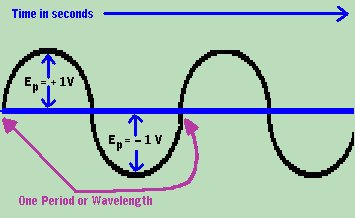


Characteristics of a Sine Wave A sine wave has several important characteristics.
A sine wave has several important characteristics.

 Now without going into a whole bunch of math and physics...(yea, RIGHT!)... you learned sometime in your life that there is a relationship between distance, time, and speed. If you are driving down a road at 50 miles per hour, for exactly one hour, you know from basic math that you will have traveled exactly 50 miles. Why?
Now without going into a whole bunch of math and physics...(yea, RIGHT!)... you learned sometime in your life that there is a relationship between distance, time, and speed. If you are driving down a road at 50 miles per hour, for exactly one hour, you know from basic math that you will have traveled exactly 50 miles. Why?
Distance = Speed x Time This is a basic law of physics. It also applies to electricity and waves. If a Wavelength is a length (read: Distance) then we can use time to compare the speed at which it travels through space. Now electricity travels at the speed of light, but what exactly is that? Well, it differs slightly from one medium to another, but for our purposes, we will assume the speed of light in a vacuum. Wavelength = Speed x Time We know that
 Using this formula we can plug in the numbers  Now by simple division, we get the following answer:  Now if a 2 meter long signal is equal to 6.67 nanoseconds, we can find the frequency of the signal as follows:  Let's plug in the numbers...  Since we know that 149MHz = 2 meters in length, we can deduce that frequency and wavelength have a relationship such that: Wavelength (in meters) = 298 / Frequency (in MHZ) or if you prefer: Wavelength (in feet) = 936 / Frequency (in MHZ) Let us test this theory. The 11 meter band, otherwise known as the CB Radio, or Citizen's Band, resides at (approx.) 27 MHZ. Does the math work out?  The formulas you can look up in the future, should you need them. The basic knowledge we have tried to stress here is, that WAVELENGTH is a DISTANCE, a PERIOD is an amount of TIME, and that FREQUENCY is the number of wavelengths in a second. Furthermore, we stressed that all of these terms are related, but not quite interchangeable. |
| (On The Following Indicator... PURPLE will indicate your current location) | ||||||||||||||||||||||||
| 1 | 2 | 3 | 4 | 5 | 6 | 7 | 8 | 9 | 10 | 11 | 12 | 13 | 14 | 15 | 16 | 17 | 18 | 19 | 20 | 21 | 22 | 23 | 24 | 25 |
| 26 | 27 | 28 | 29 | 30 | 31 | 32 | 33 | 34 | 35 | 36 | 37 | 38 | 39 | 40 | 41 | 42 | 43 | 44 | 45 | 46 | 47 | 48 | 49 | 50 |
| 51 | 52 | 53 | 54 | 55 | 56 | 57 | 58 | 59 | 60 | 61 | 62 | 63 | 64 | 65 | 66 | 67 | 68 | 69 | 70 | 71 | 72 | 73 | 74 | 75 |
| Otherwise - please click to visit an advertiser so they know you saw their ad! |
